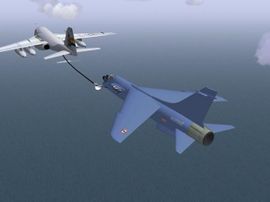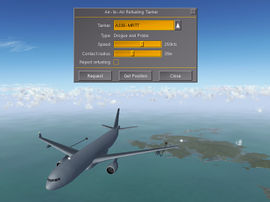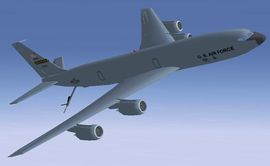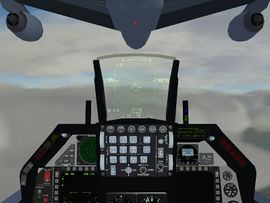Howto:Aerial refueling
Aerial refueling, also called air refueling, in-flight refueling (IFR), air-to-air refueling (AAR) or tanking, is the process of transferring fuel from one aircraft (the tanker) to another (the receiver) during flight.
What is possible
At present, there are three tanker aircraft and several receiving aircraft capable of in-air refuelling:
Probe/Drogue
| Aircraft | Can be refueled by |
|---|---|
| Douglas A4 Skyhawk | Airbus A330 MRTT
Boeing KC-135 Douglas A4-F Grumman KA-6, Lockheed Martin KC-130 |
| English Electric Lightning | |
| F-8 Crusader | |
| Grumman A-6E | |
| Grumman F-14 Tomcat |
Boom
| Aircraft | Can be refueled by |
|---|---|
| Boeing EC-137D | Airbus A330 MRTT |
| Fairchild A-10 | |
| General Dynamics F-16 | |
| Lockheed F-117 Nighthawk | |
| McDonnell Douglas F-15 Eagle | |
| Northrop T-38 |
When flying one of these aircraft in the default scenery area, one can locate the tanker aircraft using air-air TACAN and/or radar and then receive a full or partial load of fuel by flying in close formation behind the tanker. Refuelling is also possible between aircraft in a multiplayer session. It is not possible to control the boom/hose position yet; they are always operable when the tankers are air-born.
Implementing aerial refueling capability to other aircraft is pretty straight forward, as explained in this article. It does not require much coding-skills and can be done by the average FlightGear user.
Receiving fuel
Necessary preparations
Request a tanker at current position
As of FlightGear 2.4.0 you can request a tanker close to your current position, via the in-sim AI > Tanker Controls dialog. The tanker AI dialog allows you to select one of the appropriate tanker types, set the airspeed and the contact radius. The contact radius is a useful approximation of realism as it allows you to receive fuel based on your ability to hold position.
The AI tanker aircraft has a simplified flight model which isn't affected by the atmospheric simulation. This means that it can be hard to hold position in bad weather.
AI Scenarios
There are some AI scenarios that place a tanker aircraft at a specific position flying a predefined route. Generally these scenarios are less useful than the AI Tanker dialog. To use one of these scenarios it much first be activated from the AI Traffic and Scenario settings dialog (or in the command line).
Certain aircraft such as the A4F, Lightning or T38 automatically load a scenario containing a tanker.
In the cockpit
Perhaps the first thing to do after starting the engines, if necessary, is to select the appropriate TACAN channel if your aircraft is so equipped. Enter the channel using the relevant dropdown boxes in the radios dialogue (Equipment > Radio Settings or press F12). Note that you should pick the channel according to the tanker's callsign (see the table above).
| Tanker callsign | TACAN |
|---|---|
| ESSO1 | 040X |
| ESSO2 | 041X |
| ESSO3 | 042X |
| TEXACO1 | 050X |
| TEXACO2 | 051X |
| TEXACO3 | 052X |
| MOBIL1 | 060X |
| MOBIL2 | 061X |
| MOBIL3 | 062X |
You should now see the current bearing to the tanker indicated in the nav display of the A4 or the TACAN indicator (green needle) in the Lightning. If the tanker is within range, it will also appear on the radar display of the T38 or Lightning.
Now, take off.
In the air
General procedure
Turn to an appropriate heading, guided by the TACAN bearing (you should try a "leading" approach to close in on the tanker) and look for the tanker on the radar or nav screen. Around 5nm away, you should reduce your speed to around 20kts faster than the tanker (these fly at 280 kts TAS). The KC-135 will be visible from about 10nm, the KA6-D, being smaller, just over 1 nm. Use airbrakes to keep control of your speed should you find yourself overshooting.
Close to within 50ft of the tanker (do not get too close, or visual artifacts might hide the boom from view). You should see indication in the cockpit that you are receiving fuel (there is a green light in the A4 fuel gauge, as well as a green light on the right side of the T-38's panel), and you should see the indicated tank load increase.
Getting to this stage is not necessarily easy - it can take a lot of practice. As with carrier landings, this is not an easy manoeuver in real life either and there are additional complications in the sim. The tanker, being an AI model, is unaffected by the wind and flies TAS (True Air Speed), while you are flying IAS (Indicated Air Speed) and are affected by the environment. As in real life, your aircraft will also steadily increase in weight as the tanks fill which will affect the trim of the aircraft. You might find it helpful to use the autothrottle to help control your speed (Ctrl+S then Page up or Page down to increase and decrease the set speed).
Once your tanks are full, or you have taken as much fuel as you wish, close the throttle a little, back away from the tanker and continue your intended flight.
Troubleshooting the approach
If you had problems approaching the tanker, then it is useful to understand just what the cause of the difficulty is, so that you know what to practice. In a nutshell, what you have to do is to fly to the right spot behind the tanker, in such a way that the relative velocity with the tanker is zero. The first part, flying to the correct position, is easy - just keep the tanker centered in your visual field and fly till you are there. All the trouble is in matching the velocity. Successful aerial refueling thus requires precision control of your airspeed.
This, again, would be no problem if the throttle would directly control your airspeed - then you could just set the throttle to the airspeed you need as soon as you reach the right spot. However, the throttle controls thrust, and airspeed results from an equilibrium between thrust and drag which takes some time to reach. Let's assume you have reached the right spot behind the tanker with the correct airspeed, but with insufficient thrust, and see what happens: Since the drag force is now larger than the thrust, the plane starts to settle into a new equilibrium and the airspeed will slowly drop. A few seconds pass before the airspeed gauge reflects this, as gauges usually do not work instantaneously. Thus, but the time you notice the chance in airspeed from the gauge, the plane is already slower than the gauge indicates. Assume you try to correct you increasing thrust a bit. It takes a few moments before the turbine spins up to the new RPM setting (like gauges, they don't react instantaneously), then more thrust is generated. From that moment on, it takes a few seconds for the plane to settle into a new equilibrium airspeed corresponding to that thrust level. By the time that is reached, some 20 seconds may have passed - and you may find yourself already far behind the tanker!
That time-lag between recognizing airspeed changes and reaction of the plane to thrust is the prime reason why Air-Air Refueling is so difficult. A second reason is that planes usually do not just get slower when you reduce thrust or apply airbrakes - the nose of the aircraft tends to drop as well and you have to compensate. The solution to all problems is that you need to anticipate the reaction of the aircraft to what you're doing and that you need to act quickly and decisively. For this, you have to know the aircraft you're flying well.
First, never fly by the airspeed gauge in close proximity to the tanker, always react to what you see - if you see the tanker fly away, you are too slow no matter what the airspeed gauge says! If you react to what you see, you gain precious seconds (and that takes care of the wind effects, i.e. the fact that the tanker flys TAS whereas you IAS as well). Second, change thrust before you see the effect. Assume in the above example, you'd give a short burst of thrust, then put the thrust lever back to a slightly higher setting than it was before. If done just right, the airspeed drop gets compensated almost immediately and the new equilibrium is reached quickly without falling far behind the tanker. Finally, use altitude to your advantage instead of fighting it. If you pull the nose up, you'll lose just a bit of airspeed, so if you approach a bit below the tanker being a bit faster than the tanker, you can pull up as soon as you reach the spot, and you will stop just fine in the correct spot.
More advanced topics
Multiplayer refuelling
|
|
Refuelling is possible within a multiplayer session given certain conditions. A basic flyable KC135 model is available - the pilot of this aircraft should use the callsign "MOBIL1", "MOBIL2" or "MOBIL3". Other numbers are acceptable, but only these three have A-A TACAN channels assigned. These are 060X, 061X and 062X respectively.
If the receiving aircraft uses a YASim FDM, there are no further complications. Should the receiving aircraft be JSBSim based, the user must make sure that there are no AI tankers in their configuration. This means disabling (commenting out) all refuelling "scenarios" in the relevant aircraft-set.xml and in preferences.xml.
MP refuelling works in exactly the same way as AI refuelling and is a fun challenge. It is best to ensure that your network connection is as free from interruptions as possible; the MP code does a degree of prediction if there is a "blip" in the stream of packets and this can make close formation flight very difficult or even impossible.
See also Chat Menu
Selecting different scenarios
There are several AAR scenarios available in the AI directory. refueling_demo.xml has a KC135 circling near KSFO at 3000ft; refueling_demo_1.xml the KC135 on a North/South towline at 8000ft and refueling_demo_2.xml the KA6D on a similar N/S path but at 8500ft.
These can be selected by several methods; using the --ai-scenario command line option, or by editing preferences.xml.
Command line method
Add the --ai-scenario option to your usual FlightGear command line; eg.:
fgfs --aircraft=lightning --ai-scenario=refueling_demo_2
Preferences.xml method
Use your operating system's search facility to locate this if you don't know where it is). Open preferences.xml in a text editor (e.g. notepad if on windows) and search for the <ai> </ai> tags. Place a line like <scenario>refueling_demo</scenario> somewhere within the <ai> tags; you should see other scenarios already there too, perhaps commented out: i.e. with <! -- -->
Simulation vs. reality
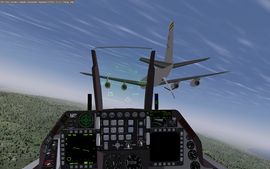
There are a few things which are (presumably) easier in the simulation as compared with the real world, but there are also some that are harder. First, the envelope for refueling is actually quite generous - you start getting fuel in a position where in the real world this could not possibly work (see picture). The real refueling position of the F-16 feels a lot less comfortable! It is also mercifully short - usually holding the plane in the correct spot for about 30 seconds is all you need. There is also no turbulence or other change in the airstream induced by the tanker modelled.
As of Flightgear 2.11, it is now possible to select a realistic refueling envelope, forcing the pilot to get much closer to the tanker (see picture).
What is on the other hand probably easier in real life is flying by eye - in reality, we usually don't have any problems accurately gauging relative motions of a few feet per second. On the screen, with finite resolution and not-exactly-real textures and shadows, a lot of visual cues are missing and gauging a small relative motion becomes difficult. Also, in real life both the tanker and the refueling plane fly in the same airstream and wind effects not being felt by the tanker AI model are not an issue.
Related content
- Category:Air refueling ready – Category with aircraft that can be refueled in flight and tanker aircraft.
- Howto: Implement aerial refueling capability
- Aerial refueling improvement ideas and resources
| |||||||||||||||||

